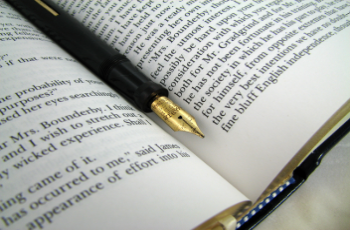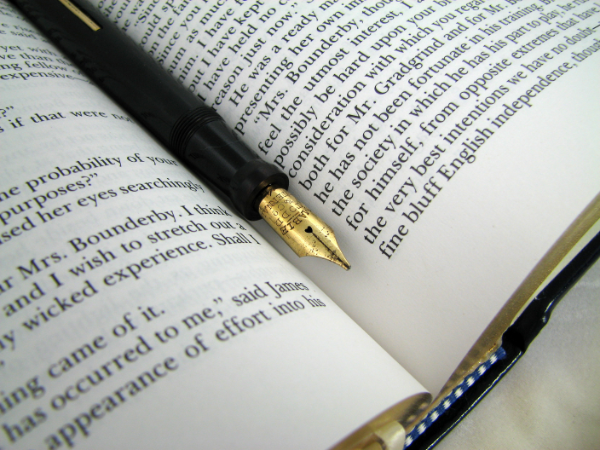
Many of you are too young to know the answer to the question, what is a fountain pen, but that’s alright, it is never too late to learn about these fascinating writing instruments!
The short answer is that a fountain pen is a writing instrument that has a reservoir of ink stored internally and uses a combination of gravity and capillary action to draw ink from that storage on to the tip of the device and create a nice even line of ink on paper.
While there is evidence that fountain pens were at least being designed and constructed by Leonardo Da Vinci in the 17th century and maybe even earlier, we are mostly concerned with either modern fountain pens constructed in the 20th century or maybe a rare possibility of ones from the very late 19th century. Anything earlier than that would most likely be in a museum or well out of the price range of most typical collectors.
Fountain pens came about as a solution to the problems of the dip pen. These dip pens were nothing more than a nib (the piece of the pen that deposits the ink onto the paper, sometimes nothing more than a pointed end with a slit in it) and a handle. Quill pens, or pens crafted from the quill feather, are a type of dip pen.
When you wanted to write with a dip pen you typically dipped the nib of the pen into a bottle of ink and then started writing on a piece of paper. As the pen started to skip or sputter, you dipped it into more ink, reloading it so to speak. While this was effective when you were sitting at your desk it was not very practical for traveling and could be messy when in a coach, train, or on a ship.
A fountain pen solved these issues by moving the ink needed from a bottle on your desk to internal storage. Early models, stored ink in a chamber sometimes sealed with cork gaskets or in a rubber bladder. These could be refilled by unscrewing one end and using a dropper to put more ink in, or by inserting the fountain pen nib into a bottle of ink and using a piston or lever to draw ink into the pen’s reservoir.
Once full, the pen could then be taken away from the bottle of ink and used throughout the day just like some people use ballpoint pens today. Once the pen was low on ink it would start skipping or be hard to start and you could then refill the pen and continue.
Fountain pens were not perfect, they could not write upside down (pencils and later the Fisher Space Pen solved those issues), could not write in the rain or underwater (the pencil again), and of course, required you to carry a supply of ink with you in fear of running out. They also tended to leak more than they should have but ballpoints and rollerballs continue to do that to this day.
The parts of the fountain pen are pretty straight forward and include the nib (broken down into the tip, nib material, slit, and feed), cap, clip (optional, to hold it in your shirt pocket), barrel, and other pieces that vary from pen type to pen type.
Filling systems include an eyedropper filler where you unscrew the rear cap on a pen and use an eyedropper filled with ink to reload the pen, a lever filler where you stick the nib of the pen into a bottle of ink and operate a level on the side to pump ink into the bladder inside, a piston filler which is like a level filler but uses a twisting piston instead of a lever, a button filler which is a level filler that uses a button instead of a lever, a snorkel filler which uses a tube that extends from the feed under the nib to suck in ink but otherwise is pretty much a piston filler, and several other types of filling systems that all perform the same functions.
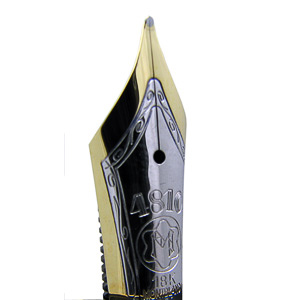
The next most interesting thing about fountain pens is the nib. This usually gold or silver colored tip is responsible for placing the ink on the page and as such has several characteristics that you may not have thought of. The first thing most people worry about with a nib is the width of the line that it draws. This typically ranges from fine (F) to medium(M) to broad(B). Certain manufacturers will also include extra fine(XF or EF), and double broad(BB), and some even more options.
Wilder variations include nibs that write differently when traveling in different directions (broader lines when moving up and down and thinner lines when traveling to the sides) and nibs with more than one ink slit.
Then there is nib flex. Flex is something you will find predominately in vintage pens although some modern manufacturers will refer to their nibs as flex or semi-flex when the amount of flex in them is minuscule compared to their vintage counterparts. What flex does is allow the writer to vary the width of the line with the amount of pressure they use pressing down on the page with the pen. This is how some of that beautiful calligraphy was done back centuries ago.
A word of caution; true flex nibs are not easy to find, not inexpensive for what they are, and can be difficult to use properly as they flex to a point, and then are permanently destroyed past that point. Many a newcomer has purchased a true flex nib, used it once, and destroyed it. Don’t be that guy. You can learn to use flex nibs properly by purchasing inexpensive modern semi-flex dip pens. Destroy one? Who cares, they are cheap and disposable.
So why use a fountain pen today? That is an excellent question! Today we tend to use our finger more than any actual writing instrument. From typing in our pin number in a grocery store for our debit card to signing a phone or tablet with our finger for a purchase at the hair salon, pens and pencils are quickly becoming something our parents used. Even schools are starting to no longer teach cursive writing which personally is pretty horrible (you don’t want your children to actually be able to read the Declaration of Independence and Constitution?).
The simple answer is that there is no simple answer. I personally love the fountain pen because it forces me to slow down, think about what I want to write and to make sure it is correct before I write it. There is no erase no backspace and no spell checker. If you misspell something or write something you don’t like, throw that paper away and grab another sheet to do it all over again. Yes, that sounds hard, but it is amazing how relaxing fountain pen writing can be to take your time and spend half an hour writing a page of a letter to someone.
Speaking of writing letters, that is an amazing part of using a fountain pen. We all love to be able to send a text message to someone and get an instant reply, or if we have a little more time or need to convey a lot of information, send an email which we expect to arrive within a couple of minutes at the most. There is something special about opening your mailbox (your actual mailbox, on the outside of your home) and seeing a hand-addressed envelope. That means someone cared enough to take the time to sit down and actually think about what to write.
Maybe I am old fashioned but sometimes I prefer getting a birthday card instead of just a text, an actual gift instead of a gift card, and a handwritten letter instead of an email. This is particularly a lot of fun when the fountain pen ink they use is a wild color, or even better, they used several different colors of ink! That tells me they actually put some time and effort into what they were doing instead of having their phone automatically send me a happy birthday text at 10:21 am (have to use an odd time so it doesn’t look like an automatically scheduled event).
What if you don’t have anyone to write letters to? Sure, it is possible all your friends are right there in town with you and it seems silly to physically mail a letter down the street. In that case, you can join what is called a snail mail list. These are lists of people who want to send and receive physical handwritten letters and are open to new people writing them.
Snail mail lists can often be found on forums catering to people who collect writing instruments such as Pentrace and Fountain Pen Network.
Another interesting reason to use fountain pens is that they are fantastic conversation starters. I have had people ask me what type of pen I was using because they had never seen a fountain pen (then ask what is a fountain pen), or start reminiscing about when they used fountain pens in their youth, or just complimenting me in such a cool pen having no idea what it is. It doesn’t even have to be a fountain pen; once my wife and I were in a cafe and I pulled out my Visconti Van Gogh Starry Night ballpoint and almost immediately a server stopped by the table and asked: “is that a Visconti?”
So should you get a new or used fountain pen? Vintage or modern? That’s entirely up to you. There are a ton of options for every taste and every price range. Contrary to common belief, right now in 2020, there are probably a hundred manufacturer’s around the world making fountain pens, and probably a thousand different models to choose from. I personally have vintage pens that cost $20 up to many hundreds of dollars, and modern pens that go from $7 up to a couple thousand.
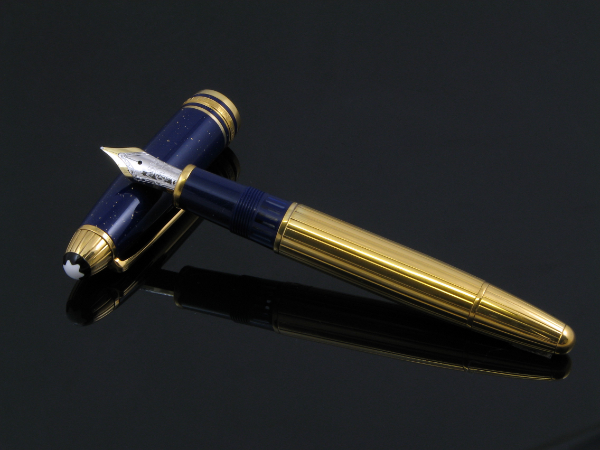
Price in the fountain pen world usually denotes how rare the pen is, what was used to make it, quality of the piece, or a combination of the three. A limited-edition Mont Blanc Ramses II LeGrand Fountain Pen will set you back a few thousand dollars and is a jaw-droppingly beautiful pen made of 18k gold and Lapis Lazuli. It is also a very good writer but is too heavy to use posted, and too heavy to carry in your breast pocket so it may not be the right choice for you. While certainly not the most expensive fountain pen, it certainly is only for those who really want something unique.
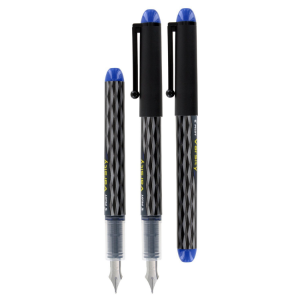
On the other end of the scale, the Pilot Varsity is an amazing disposable fountain pen that you can get for a few dollars each.
Want a cheap fountain pen that is also vintage? Nothing better than the good ole Esterbrook J that you can get for as little as $30 in good working condition. Keep in mind however that vintage pens may need work or may work fine right now and need work the second time you fill it because the fifty-year-old rubber sac that holds the ink finally tore.
Next, since I am talking about a vintage pen needing work, can you get these pens fixed? Absolutely, although maybe not locally. Most people either send off their pens to someone like Danny Fudge at The Write Pen, or to Greg Minuskin. I have personally used both of these people and they have always done excellent work. You can also find Danny and other repair people at most larger Pen Shows.
That’s right, there are pen shows! These are events where vendors, collectors, and repair people get together and put on a show. These are often sponsored by some of the larger vendors and generally cost a few dollars to get in. Some of the larger shows include the yearly ones in Los Angeles, Dallas, and Washington DC.
If you have decided to go shopping, looking for where to buy fountain pens locally could be a challenge. Vintage pens can be found at flea markets and antique dealers but more often than not need work before they can be used. New modern pens can be found at many office supply stores, large malls, and stationery stores. Other than that, take a look online.
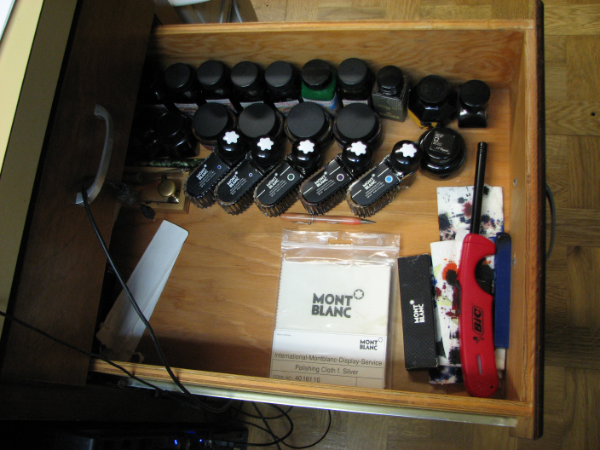
Once you have some pens, then it is time to get ink and all the cool things that go with the pens to make it just a ton of fun.
Browse around the site here and you will find a lot of articles including topics such as fountain pen reviews, how to fill a fountain pen, and how to use a fountain pen.

